
So… Is that Art?

Contributor
I was meandering through the garden with my brother-in-law when he stopped in front of an iron sculpture and asked, musingly, “So… Is that art, or is it just junk?” My first reaction was to administer a sharp right hook using muscles I have toned over several years of dragging interesting metal pieces home for further consideration. But I remained calm and we went on. The question has stuck with me, though, and I often return to it as our garden grows along with my impulse to embellish it.
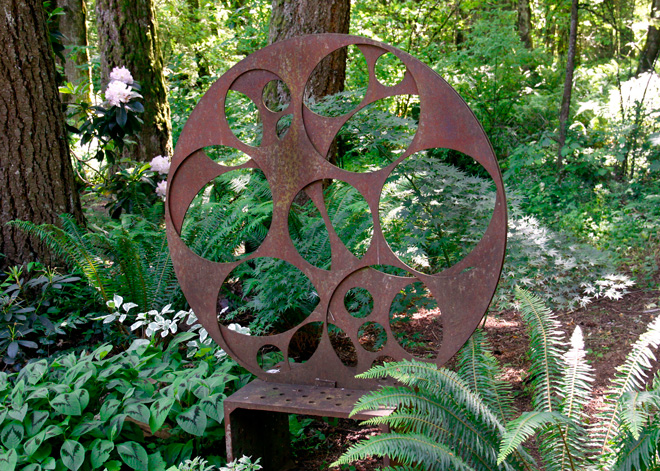
Over the years my garden has evolved in response to typical life changes. Children who needed tree forts and soccer lawns grew up. And the weddings of these grown children required romance, botanically speaking. Large lawns increasingly feeble under the spreading canopy of surrounding trees gave way to shade beds. And once strong backs now ache, literally, for evergreen ground covers that reduce the need for weeding. Along with these changes has come the wish for focal points that require neither pruning nor winter mulch. Sculpture is the answer!
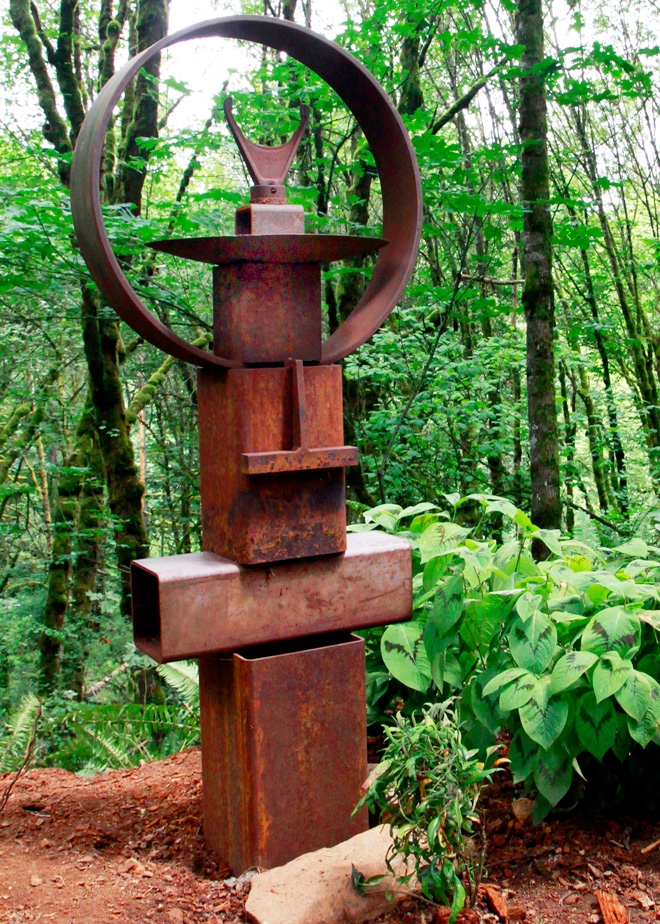
Artistically, I’m all for iron, rusty or otherwise. It’s organic, durable, malleable, and versatile. My early gardening mentor was a rustaholic and some of that rust rubbed off on me. My garden has lots of iron sculpture created by gifted artists and plenty that I have fabricated using previously under-appreciated found pieces.
Rusty iron’s patina blends well into a woodland setting. It offers a nice contrast to leafy surroundings without stealing attention from the main show. Then, in winter, when the leaves disappear, the metal makes a strong statement. It also stands up to the rigors of extreme precipitation and falling debris.
For the DIY gardener/sculptor, a light-gauge piece of mild steel can be shaped fairly easily using a variety of tools found in the average garage. I don’t recommend going to the extreme of trying to bend a piece of thick steel by putting it on the ground and using the car to run over it. My garden mentor tried that. The metal barely dented but it did flip up and surgically remove her car’s muffler and some other thing that turned out to be necessary for locomotion.
You’ll find interesting and artful scraps at steel fabrication facilities where the plate steel remaining after shapes have been cut from it (think sugar cookie dough remnants after the cookies have been cut out) is piled in a boneyard until it is sold or recycled. My favorite steel yard has had, over the years, wonderful holey panels of alphabet letters, rectangles, circles, crescents, widgets, flying ducks, moose, and ivy leaves. These make great privacy screens, trellises, gates, fences and free-standing art pieces. Smaller forms hung on chain or rope make excellent gongs.
Salvage yards are full of inspiring material, as well. Large sewer rings can become moon gates, and large-diameter iron pipe and tube steel can form wonderful planters or supports and stands for other types of garden art. A set of square tube steel sections set close together at various heights makes an excellent planter for succulents. Imagination is the ingredient that changes a bunch of “junk” into art.
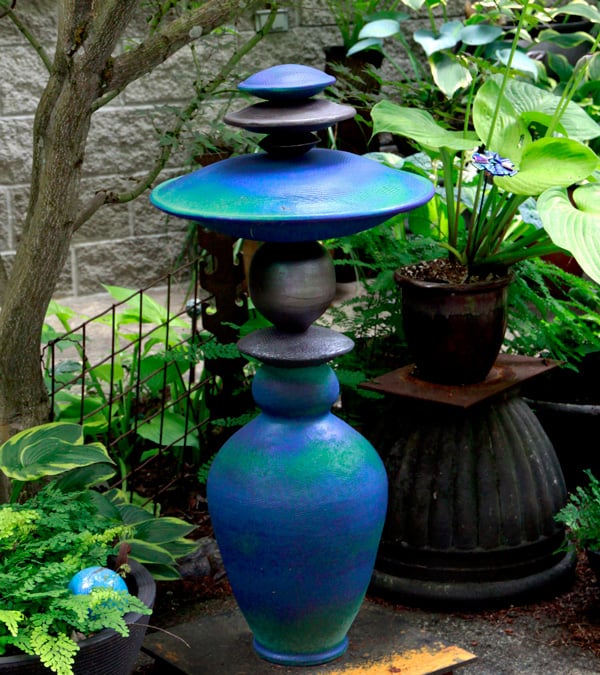
West of the Cascades in Oregon and Washington, garden art is a form of anti-depressant. It moderates the oppressive green that overtakes us each spring. We welcome smiling gnomes, grinning ceramic toads, laughing bronze children, and even larger-than-life stoneware slugs to our gardens, in an effort to divert attention from the inexorable march of plant life, both domestic and wild, that accompanies warming temperatures. Dear friends of mine have gone to the extreme of planting whole flocks of flamingos in traditional pink as well as in New Age colors. In doing so, they feel a sense of solidarity with one another and celebrate the flocking instinct that brings us together as friends and gardeners. This act of flaunting flamingos secures our common goal of keeping gardening where it belongs: a cement to friendships and an aid to good mental health. Besides, a bunch of flamingos does a superb job of luring eyes away from a persistent patch of creeping buttercup.
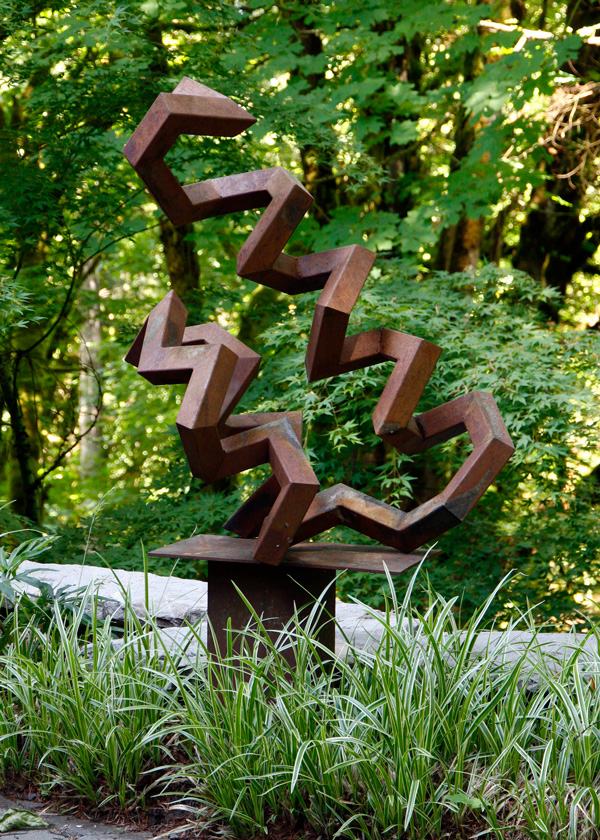
Garden books are full of advice and rules about where and how to install garden art. But these gorgeous tomes are meant for the coffee table, which is where they belong. We can do whatever we like in our own gardens. (I guess this includes the neighbor who mows his back yard in a Speedo and cowboy boots; it will be nice when the clematis finally covers his chain-link fence.) My own garden is large and I have many friends who are artists. I don’t wait for a new bend in the garden path so that the piece appears in solitary splendor. Instead, I like to place a piece every few yards, aiming for an overall harmony, and anybody who doesn’t like it is free to complain. I’ll put new complaints in the same basket as the one lodged by the plummy-voiced visitor who caroled, as I remained concealed behind a rhododendron, “Why would anyone put that ghastly ‘thing’ beside such a sweet rose?” The “thing” was blown glass with the same delicate tint as the rose—that is until a fir branch blew down and broke the piece. Maybe my little concrete garden god gave Ms. Plummy the last word after all.
Don’t let anyone tell you that “real art” and whimsy can’t coexist. It’s all in the eye of the critic. I have a formidable vertical piece of iron, slate, and concrete by Dutch artist Jan Kalisvaard. One day, a couple and their wilting 9-year-old visited on an Open Garden day. The poor child’s boredom was palpable (one can only hope the parents eventually received proper karmic punishment for dragging him along). As the grown-ups made appropriately ritualistic comments about the sculpture I mentioned to the son that I call the piece “Sasquatch Finder” because it has a small rectangular spy-hole and looks out over a canyon of hundreds of acres where lots of wild things reside. He spent the rest of the forced visit glued to the viewing hole watching the parade of fauna below.
I especially like art that makes noise in the garden, like the 48-inch bronze wind gong hanging in our stone gazebo. It makes a wonderful, thunderous boom when struck, and gives the striker a thrilling sense of empowerment. There are two more gongs, a small steel drum, a bronze Soleri bell, and a mystical Aeolian harp that sings when storms brew up a sharp south wind. All these pieces engage visitors and encourage them to participate in the garden’s experience.
The artists whose work we admire every day as we wander, march, or sprint through the garden from house to barn have come to us in a variety of ways. A tall, ceramic totem by Portland artist Victoria Shaw was coveted for years before being purchased directly from her.
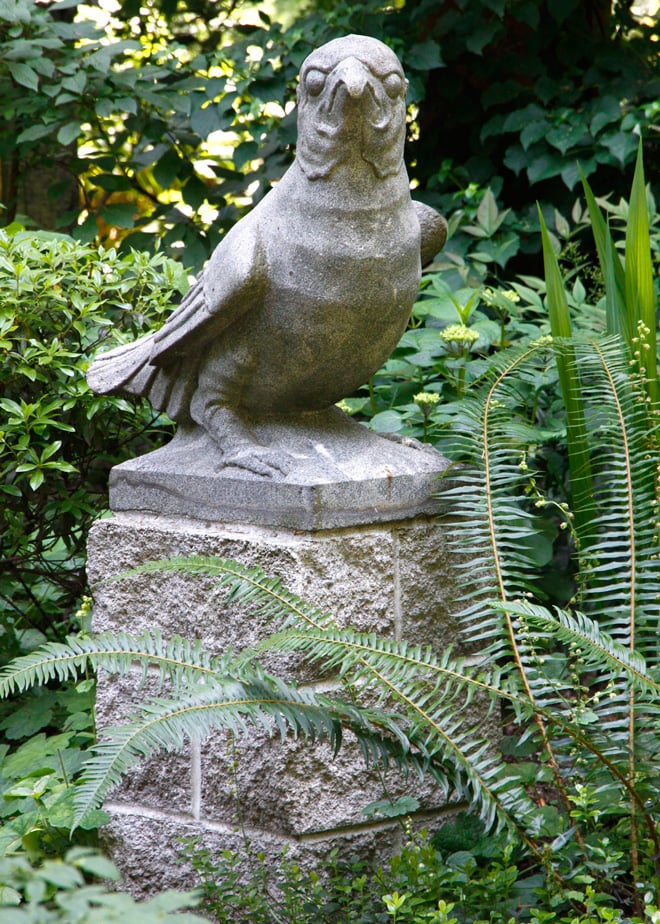
I spied two granite falcons, originally from a building in Thailand, sitting askew outside the door of a junk shop, too heavy to be hoisted over the threshold. Fortunately, the phrase “where there’s a will…” is spot on, and I was able to bribe my patient spouse to help wiggle the 200-pound birds into the back seat of my car for the trip home. Today they sit on concrete pillars guarding the entrance to our sun garden.
I lusted after a splendid Cor-ten steel birdbath by international artist and friend Devin Laurence Field, which, to my disappointment, had been sold to someone else. Eventually, in the way life sometimes turns out, we saw it at a fundraising auction and made sure we were the successful bidders.
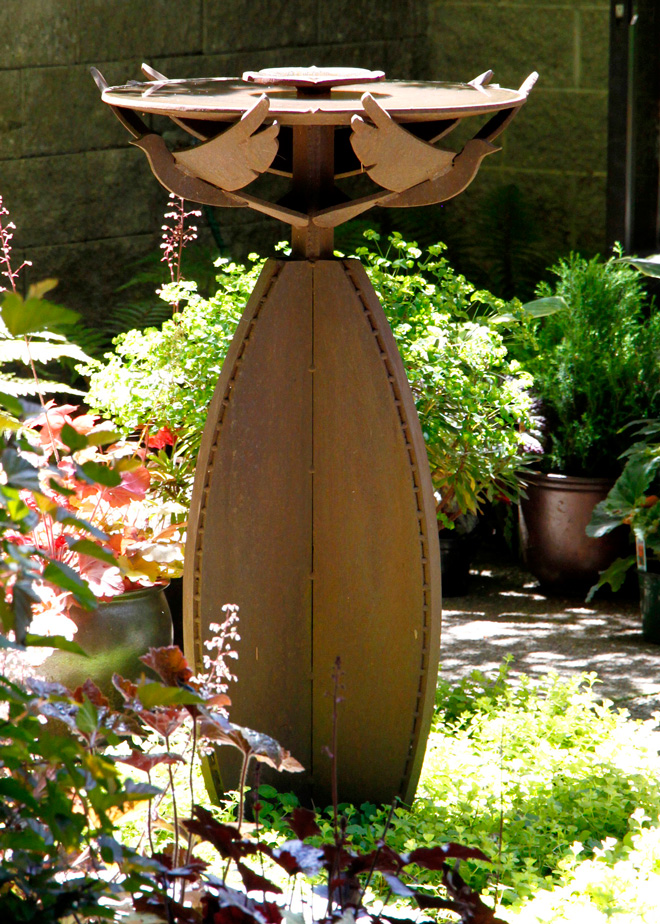
A flame-like piece on the roof of our gazebo by Ben Dye, an Oregon artist, was the result of my husband’s casual comment that the gazebo was such a boring structure that “the only thing that could make it interesting would be to set it on fire.” I’m happy to say that both the flame sculpture and the gazebo survive to this day.
Pieces by another Oregon artist, Kate Simmons, make frequent appearances. We first met Kate when she was an art student and over the years have installed her welded panels on the concrete walls of the house. Her steel “pods” are beautiful in their own right, but are also excellent holders for other pieces of art.

An iron oxide-glazed stoneware female torso by prolific artist and neighbor, Marilyn Woods, occupies an appropriate spot among maidenhair ferns on the patio. One of her inviting water bowls brings light to the entrance of our gazebo, and her lovely small woodland totem graces our entry.
“Aztec bench” by Northwest artist Dave Hazlett, is the focal point in our driveway turnaround. It is carved of salt-and-pepper granite from Orcas Island in Washington’s San Juans. We admired the piece for a year when it was on display as part of our town’s annual municipal art walk and bought it after the show ended.
Another interesting piece of welded tube steel is the helical work of the German experimental physicist and sculptor, Julian Voss-Andreae, who is also responsible for a similar but much larger piece honoring Nobel Laureate, Linus Pauling.

Our most recent acquisition is a 1600-pound planter made by another Oregon artist, Joe Rivera, of the Stastney Gallery. The planter was delivered by the artist and attached to the front loader of our tractor. Inching it into place was a white-knuckle experience that we will remember every time we admire the planter and the lovely Japanese maple it now contains.
Almost every day I have yet another garden art epiphany. Big nylon banners would provide fantastic color and motion! I yearn for the soft evening glow of dozens of solar-powered Chinese lanterns. I would love to install Christo-like swaths of tulle between the 150-foot Douglas fir trees that shade our property. Then I remember the incessantly drifting fir needles that fall from the trees much the way hair falls from our corgi. The recollection encourages me to stick with the kind of solid decoration I can pressure wash and I’m off to the steel yard again to ferret out something new with which to bedevil my brother-in-law.
Artists mentioned in this story:
Ross Barrable – www.soundscapesinternational.com
Ben Dye – www.bendyesculpture.com
Devin Laurence Field – www.devinlaurencefield.com
Dave Haslett – www.orcastone.com
Joe Rivera – www.stastnystonepots.com
Victoria Shaw – www.vshawsculpture.com
Kate Simmons – www.linkedin.com/pub/kate-simmons/23/880/b09
Julian Voss-Andreae –www.julianvossandreae.com
Marilyn Woods – www.woodshillstudio.com











Responses